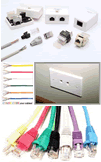 |
Phone: +44 (0)161 928 4719
Email: info@costelloselectrical.co.uk
|
 |
|
|
|
 |

|
|
|

 Ethernet networks use industry standard cabling types to transmit data between different computers and other devices on an office network. It is essential that you choose the correct cabling for your networking speed requirements, or check that existing structured cabling in an office meets your needs.
Ethernet networks use industry standard cabling types to transmit data between different computers and other devices on an office network. It is essential that you choose the correct cabling for your networking speed requirements, or check that existing structured cabling in an office meets your needs.
Twisted-Pair Cable
Twisted-pair cabling is made from copper wires and used in most modern networks (and also used for telephone communications). Twisted-pair is a pair of wires twisted together to form a circuit that transmits data. There are two basic types: Unshielded Twisted-Pair and Shielded Twisted-Pair:
Unshielded Twisted Pair (UTP)
UTP is the most popular cabling type - used with most of the major networking architectures and available in several categories: Cat-1, Cat-2, Cat-3, Cat-4, Cat-5, Cat-5e and Cat-6. Cat-5 is commonly used today as it delivers up to 100 Mbps. Cat-5e is also very popular as it supports up to 1000 Mbps (Gigabit Ethernet). Cat-6 is the latest and greatest type of UTP cabling and is the fastest standard. Cat-1, Cat-2, Cat-3 and Cat-4 are rarely used today as they have limited transmission speeds, up to a maximum of 16 Mbps.
UTP cable has a narrow diameter, which eases installations, as the wires are flexible and do not fill up wiring ducts as quickly as other cable types. UTP is the least expensive per meter and although once considered slow, it is actually the fastest copper-based medium. The downside is that copper-based UTP is more prone electrical signal interference and requires signal boosts at shorter intervals - every 100 metres. UTP is connected to computers and network devices via RJ-45 connectors.
Shielded Twisted Pair (STP)
STP prevents interference better than UTP, because the cabling is 'shielded', providing higher protection against electrical interference, however it is more costly and difficult to install. As a consequence, STP is rarely used to cable Ethernet networks. STP only supports transmissions speeds of up to 100 Mbps and each cable length is also limited to 100 meters before requiring a signal boost.
Coaxial Cable
Coaxial cable is an older copper-based cabling type that supports 10 and 100 Mbps and is fairly inexpensive, although more expensive than UTP. However Coaxial cable can be run over longer distances before a signal boost is required - up to 500 metres.
Coaxial is available in a choice of sizes (cable thickness): Thicknet and Thinnet. Thicknet is too rigid to install easily in some buildings and therefore rarely implemented. Thinnet used to be installed because it could be laid around twists and corners, due to its flexible nature. However, Thinnet had to be grounded properly to ensure a solid electrical connection. Many installers failed to achieve this and suffered with signal interference as a result. For this reason, Thinnet is rarely used - UTP is the preferred choice as it is easier to install.
|
|
|
|
|